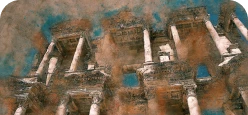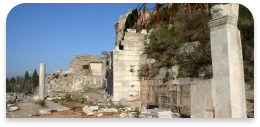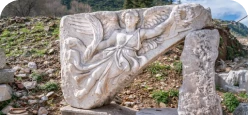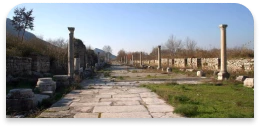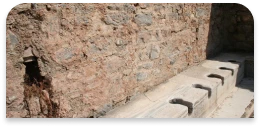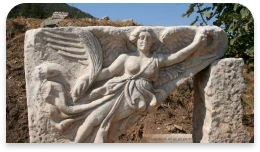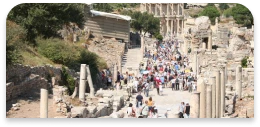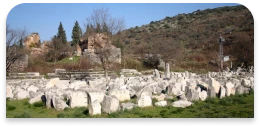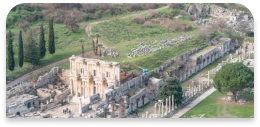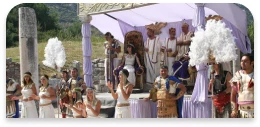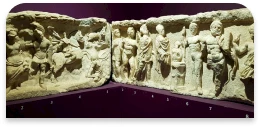El Anfiteatro o Gran Teatro
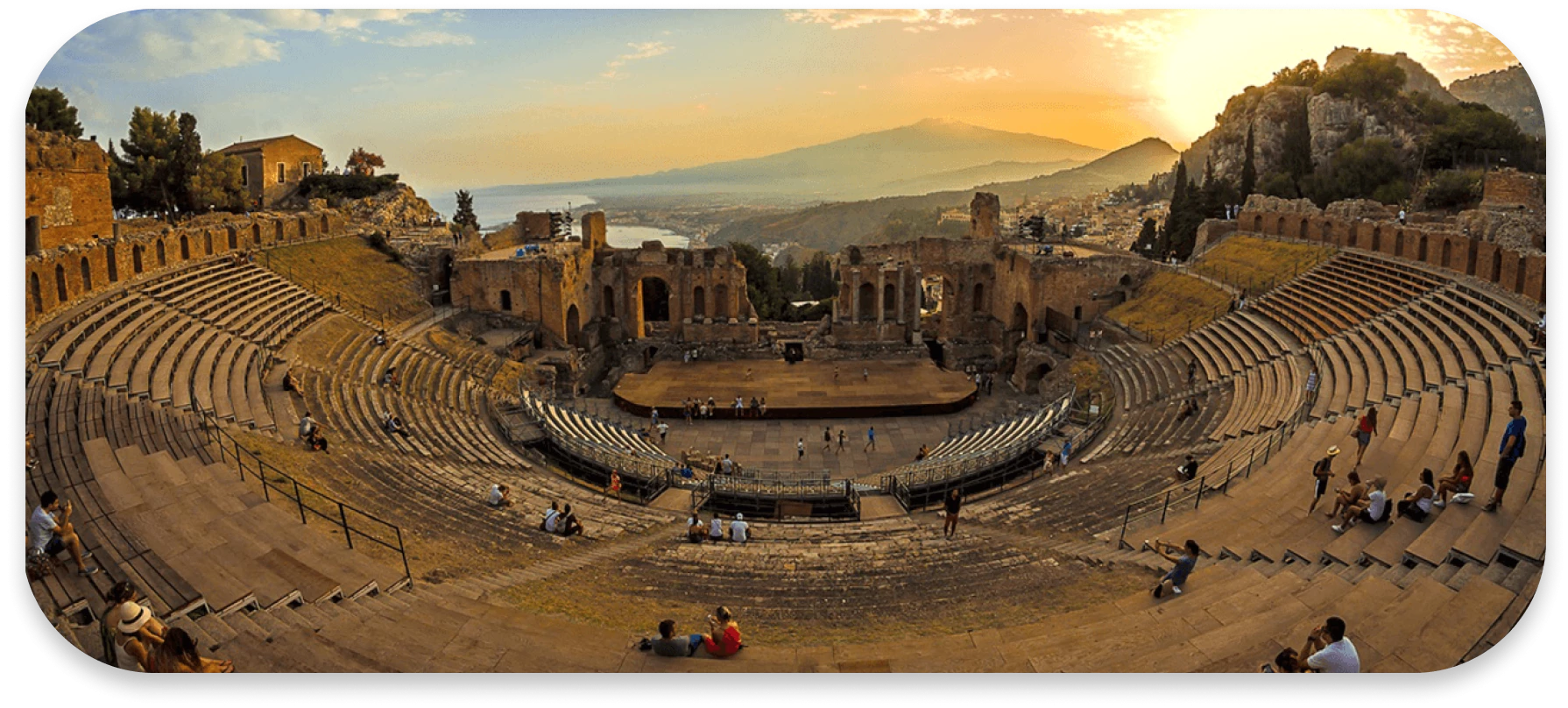
Of all the archaeological remains from Antiquity, the Ephesus theatre is the most magnificent structure in Ephesus' ancient city.
Where is Ephesus Theatre located?
The Ephesus Great Theatre is located on the slope of Panayir (Pion) Hill, opposite Harbor Street, and is easily seen when entering from the south entrance to Ephesus. The theatre is cut into the west slope of Mount Pion upon which the Acropolis was located. Hellenistic theatres are generally built on a natural slope of a hill in order to benefit from the gradient of the hill. The best example is the Acropolis Theatre of Pergamum which was constructed in the 3rd century BC, almost at the same time with the Ephesus Theatre. The excavations of the Great Theatre reveal that it was first constructed about 250 B.C, during the reign of Lysimachos. During the Roman period, it was enlarged and formed its current style that is seen today.
Ephesus was laid upon a grid system such as any other Hellenistic ancient city. According to this layout, major public buildings are located along the principal streets. One of the major streets of Ephesus, Arcadian runs between where the Harbor and the Great Theatre.

Una vez hayamos adquirido la entrada, comenzaremos con el recorrido que se marca. A través de las grandes piedras desembocaremos en el anfiteatro. A primera vista, parece pequeño. En realidad, es muy grande: las inmensas escaleras, las piedras talladas, las columnas aún en pie… ese carácter tan de fortaleza que engaña a primera vista. El anfiteatro se utilizaba para obras de teatro, conciertos, lucha de gladiadores, reuniones políticas o religiosas, con una capacidad para 25 000 personas.
El entretenimiento era también parte de la antigüedad en Éfeso y esto es claramente evidente con la estructura del Gran Teatro de Éfeso. Está ubicado en la ladera de la Colina Panayir y está opuesto a la Calle Puerto. Puede ser visto fácilmente cada vez que entras desde el área de entrada del sur de la antigua ciudad. El Gran Teatro fue construido durante el Período Helenístico. Cuando el período Romano comenzó, la estructura en su totalidad fue expandida y se convirtió en lo que puede encontrarse ahora. El Teatro de Éfeso es considerado el más grande de Turquía o de la antigua Antioquía. Tiene una cávea construida con 66 filas de asientos divididas en 2 diazomas junto a 3 secciones horizontales.
En los alrededores del teatro, los asientos se dividen en 3 secciones. A lo largo de las secciones más bajas, se usaron piezas de mármol para la restauración. Esta es la sección donde se encuentra el cubículo del Emperador. Los asientos diseñados con espaldares, también hechos de mármol, normalmente estaban reservados para personas importantes en la sociedad, mientras que la parte alta de la cávea es donde entraba la audiencia.
El escenario del Gran Teatro de Éfeso también tiene 3 pisos y una altura de 18 metros. Su fachada que mira hacia la audiencia está ornamentada con varios relieves, columnas junto a nichos, estatuas y ventanas. En el área de la orquesta, se encuentran 5 espacios de puertas donde la puerta central está diseñada para ser más ancha. Esto le daba al escenario la apariencia de ser más grande de lo que era realmente y le da un aspecto monumental único. Además de utilizar el Teatro de Éfeso para obras y conciertos, era también utilizado para discusiones políticas, filosóficas y religiosas. Más aún, también era utilizado para peleas de animales y gladiadores fijadas por los administradores para entretener a las personas de la antigüedad.
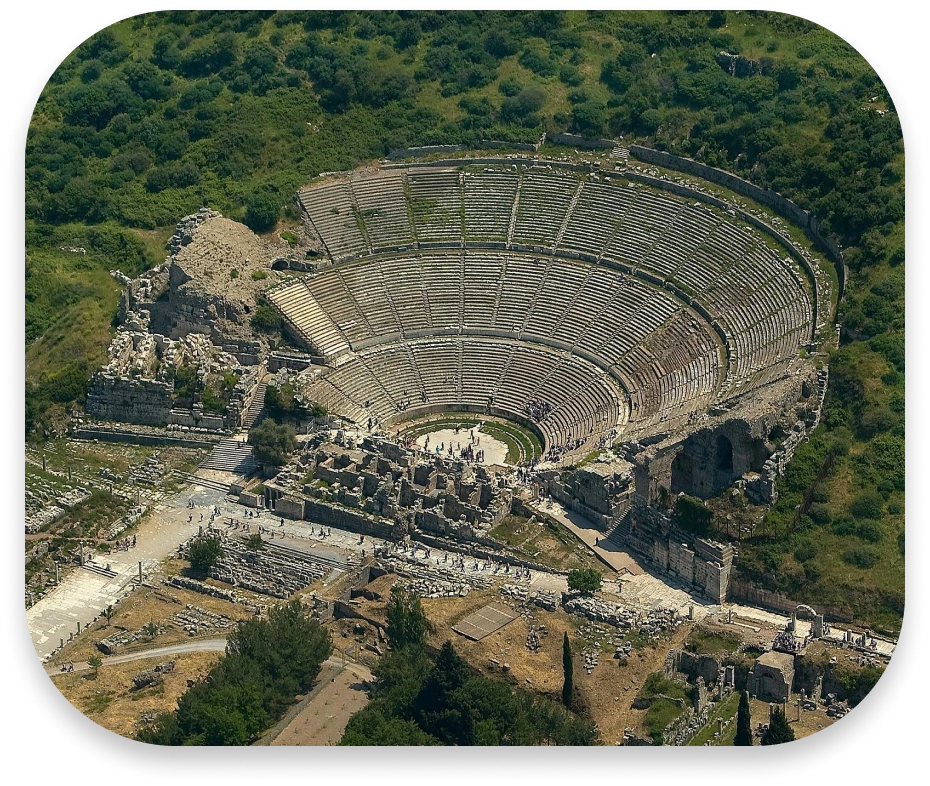
The Riot in Ephesus
The devotion of Ephesians to goddess Artemis is well-known to Christians from the Acts of the Apostles, chapter nineteen, which describes an assembly in the Great Theatre of Ephesus. According to Acts 19, a silversmith named Demetrius, who made shrines for the goddess, instigated the cratsmen against Paul as he was in fear of losing his income from selling Artemis idols.
''You know, my friends, that we receive a good income from this business. And you see and hear how this fellow Paul has convinced and led astray large numbers of people here in Ephesus and in practically the whole province of Asia. He says that gods made by human hands are no gods at all. “
The crowd gathered around Demetrius was furious and soon the whole city was in an uproar. They seized Gaius and Aristarchus, Paul’s traveling companions from Macedonia, and all of them rushed into the theater together. Believers wouldn’t let Paul appear before the mob. Government officials, who were Paul’s friends, urged Paul not to enter the theater (Ac 19:31); the city clerk defended Paul and his companions (Ac 19:35-37).

